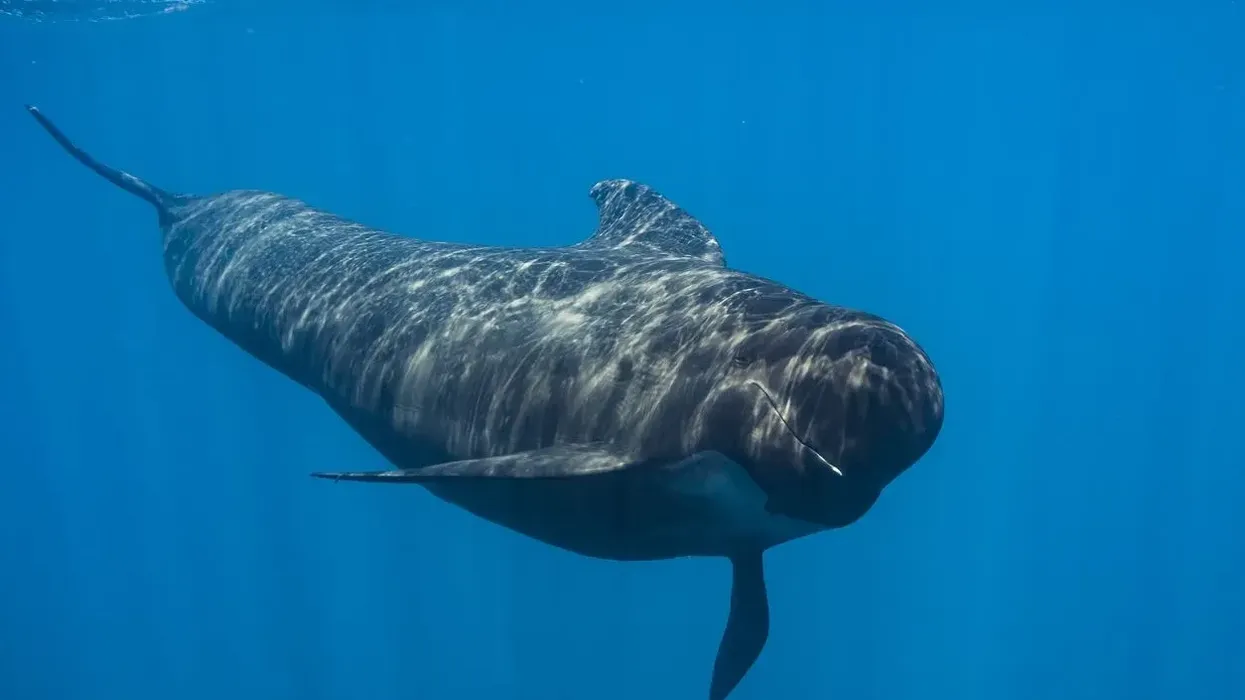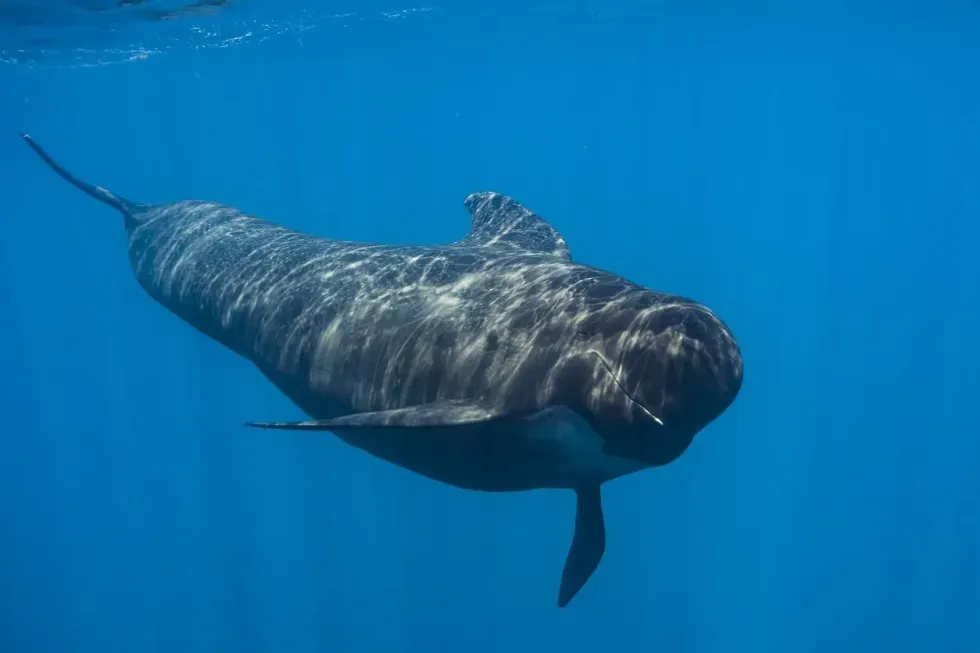The long-finned pilot whale (Globicephala melas) is a species of Delphinidae from the oceanic dolphin family. This fish species shares the Globicephala genus with short-finned pilot whales (Globicephala macrorhynchus).
Their scientific name was given due to their long pectoral fins, but pilot whales as a whole are named so because one animal takes the lead in their groups, acting rather like a pilot.
The genus is a combination of the Latin words 'globus' and 'kephale' which mean 'globe' and 'head'. The word 'melas' is of Greek origin, and it means 'black.'
In some places, pilot whales are known as the pothead whale species as early whalers thought this species looked like a cooking pot. The British zoologist Thomas Stewart Traill first classified these species in 1809 and gave them the name Delphinus melas.
The name was later changed to Globicephala melaena and the specific name was changed back to 'melas' in the year 1986.
The two subspecies of these whales are Globicephala melas melas and Globicephala melas edwardii. There was a third subspecies found in the North Pacific in Japan that is believed to have gone extinct between the eighth and 12th centuries.
If you found these facts about long-finned pilot whales interesting, then you may also read our whale shark and bowhead whale facts.
Long-Finned Pilot Whale Interesting Facts
What type of animal is a long-finned pilot whale?
The long-finned pilot whale (Globicephala melas) is of the family Delphinidae and the order Artiodactyla. This species is a group of large oceanic dolphins that are social. This species is commonly involved in mass strandings and as a pod-living species, they are highly gregarious dolphins. They exhibit both diurnal and nocturnal activities.
What class of animal does a long-finned pilot whale belong to?
The long-finned pilot whale (Globicephala melas) belongs to the Mammals class of animals.
How many long-finned pilot whales are there in the world?
The total population of the Globicephala melas (long-finned pilot whale) is unknown.
The population has been estimated by region though, so south of the Atlantic Convergence (in the Southern Hemisphere) there are approximately 200,000 pilot whales, in the western North Atlantic there are approximately 31,000 pilot whales, and in the northeastern North and Central Atlantic, approximately 750,000 pilot whales can be found.
Where does a long-finned pilot whale live?
The Globicephala melas (long-finned pilot whale)'s population is widespread across the world's non-tropical Northern and Southern Hemispheres. This species is not present in equatorial regions.
The Northern Hemisphere distribution of this marine species is in the Atlantic Ocean that surrounds Greenland, the Barents, Iceland, and the northern seas. The Southern Hemisphere distribution of this species is in the Atlantic Ocean, the Indian Ocean, and the Southern Pacific Ocean around New Zealand and Australia.
The ocean currents they occupy are the Falkland, Benguela, and Humboldt currents.
The ranges of short-finned pilot whales (Globicephala macrorhynchus) and long-finned pilot whales overlap. They have also been seen near sea ice in the Antarctic.
What is a long-finned pilot whale's habitat?
These pilot whales (Globicephala meals) are found in cool saltwater aquatic biomes of temperatures around 55.4-86 F (13-30 C). They are found in a wide range of depths from 98.4-5,905 ft (30-1,800 m). They are found around coastal and pelagic aquatic biomes.
Who do long-finned pilot whales live with?
Globicephala melas (long-finned pilot whales) have strong social skills. They display mass strandings.
How long does a long-finned pilot whale live?
Female pilot whales live longer than males. The maximum lifespan of Globicephala melas (long-finned pilot whales) females is 59 years of age whilst males typically live to 46 years of age!
How do they reproduce?
Long-finned pilot whales do not mate within their pods and males display aggressive courtship behaviors. Males forcefully collide at a heightened speed and can have more than one female as a mate at one time (polygynous).
Their breeding season starts in early summer and spring, between April and June. Males take longer than females to reach maturity as females reach sexual maturity at six years and males take around 12 years.
The gestation period lasts up to 16 months and the female produces one calf. The calf weighs around 220 lb (100 kg) and is of a length between 5 ft 3 in-6 ft 7 in (1.6-2 m).
What is their conservation status?
Long-finned pilot whales are listed as Data Deficient by the IUCN. There are several hundred thousand of these dolphins in the wild but their status is difficult to evaluate based on the wide range of their locations.
However, we do know that there has been a population decline in these marine mammals. By the 12th century, the Japanese subspecies of long-finned pilot whales became extinct. This species of pilot whale is listed in Appendix II of CITES.
Long-Finned Pilot Whale Fun Facts
What do long-finned pilot whales look like?
These pilot whales are dimorphic and pilot whales are the second largest species of dolphin despite their name saying 'whale', just behind the killer whale. Its body is black or dark gray with white or light gray on its belly and throat.
There is also an anchor-shaped patch present on its throat.
Some of these dolphins have markings like an upward-sweeping stripe just behind the eye and a light-colored region behind the dorsal fin. They have a thick falcate dorsal fin which is about a third of the length of this animal.
They have long, sickle-shaped pectoral flippers which make up 18-27 % of their body length. This species of pilot whale has single blowholes and is toothed.
Even though these species are dimorphic, it is a difficult task to differentiate females from males in the wild for many of these cetacean species.
In the past, it was believed that males had a hooked dorsal fin and females did not, but this has been ruled out by recent studies. Further discoveries on fin dimensions and other features of pilot whales are sure to come in the future!

How cute are they?
Long-finned pilot whales are really cute dolphins, if you have ever been lucky enough to see one you will certainly agree!
How do they communicate?
These marine whales are very social. They can produce many sounds like buzzes, whistles, squeaks, and rapid clicks which are a type of bio-sonar communication, known as echolocation.
These sounds allow them to sense or see in their dark surroundings by listening to the echoes that return. These pulsed calls and whistles can be arranged on a continuum and the frequency range of these calls is observed to be below 1-20 kHz.
Recent research shows that they tend to make these calls in a repeated sequence. These repetitions are usually produced when pilot whales are socializing.
How big is a long-finned pilot whale?
Average pilot whales are 19-22 ft (5.7-6.7 m) in length and males are normally larger than females. Males reach up to 22 ft (6.7 m) and females up to 19 ft (5.7 m). Interestingly, long-finned pilot whales are larger than short-finned pilot whales.
How fast can a long-finned pilot whale swim?
The data on the speed of these marine dolphins is not currently available.
How much does a long-finned pilot whale weigh?
The average weight of these dolphins is 2,900-5,070 lb (1,300-2,300 kg). Typically, males are heavier than females. Males weigh 5,070 lb (2,300 kg) and females weigh 2,900 lb (1,300 kg).
What are the male and female names of the species?
There is no specific name for female or male long-finned pilot whales.
What would you call a baby long-finned pilot whale?
A baby long-finned pilot whale is usually referred to as a calf.
What do they eat?
These marine species eat around 75 lb (34 kg) of food per day. Their prey includes mollusks, fish, and squid.
Are they dangerous?
No, long-finned pilot whales usually are not dangerous to humans.
Would they make a good pet?
No, these animals would not make great pets. These animals must be left living in groups in the wide-open oceans.
Did you know...
Long-finned pilot whales are prone to parasitic infections like nematodes, cestodes, or lice, and neurological disorders.
Since the first Norse settlement in the Faroe Islands, people have been practicing whaling, affecting populations of pilot whales. As well as the Faroe Islands, these marine creatures are also taken from seas around Greenland.
Females of the short-finned species are one of the few mammals that go through menopause.
Even though humans are the main predators of these species, large sharks are also their predators.
Long-finned pilot whales have more neocortical neurons than any other mammals and almost twice as many as human beings.
Long-finned pilot whales have been observed babysitting calves of other whales. According to many studies, it is mostly males who babysit these calves.
Like all other whale species, pilot whales are highly intelligent.
The pilot whales are nomadic but some of these whales stay in the same location for their whole lives.
Why is it called a pilot whale?
Pilot whales are named because there is a lead pilot whale in all groups within their population who acts like a pilot.
Do long-finned pilot whales have teeth?
Yes, these marine mammals are believed to have a distribution of between nine and 12 teeth in each row and their flippers are one-fifth of their body length. In contrast, short-finned pilot whales (Globicephala macrorhynchus) have between seven and nine teeth in each row and their flippers are one-sixth of their body length.
These groups of whales may ram and suck their prey into their mouth rather than grasping them.
Here at Kidadl, we have carefully created lots of interesting family-friendly animal facts for everyone to discover! Learn more about some other mammals from our blue whale facts and sperm whale facts pages.
You can even occupy yourself at home by coloring in one of our free printable Long-finned pilot whale coloring pages.









